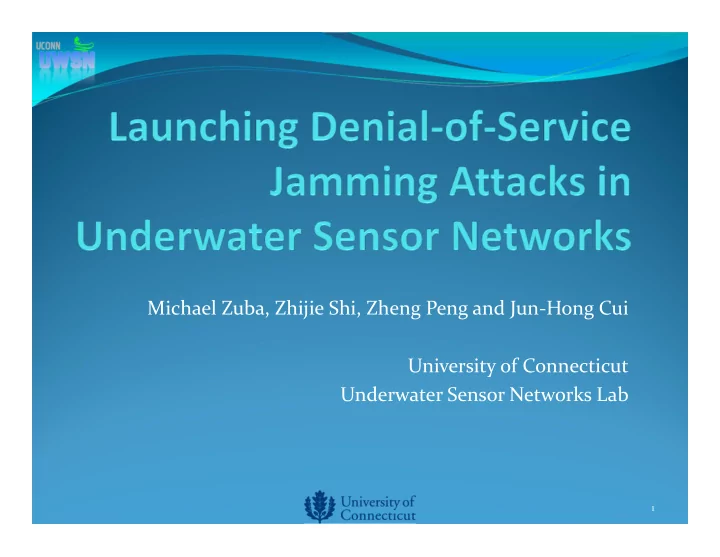

Michael Zuba, Zhijie Shi, Zheng Peng and Jun ‐ Hong Cui University of Connecticut Underwater Sensor Networks Lab 1
Underwater Wireless Networks (UWNs) What is an UWN? An interconnected system. Distributed autonomous nodes. Wireless acoustic communications. Computation & Communication. Potential applications Seismic predictions, pollution detection, Anti-submarine missions … Acoustic communication challenges Huge propagation latency. High time variation. Limited bandwidth. 2
Challenges Security Long Propagation Delay + High Error Rates Adversary can observe communication between devices. (Covert Communication is obviously more challenging!) Receiver cannot distinguish between authorized and non authorized signal. Communication interference is not addressable through conventional cryptographic security mechanisms. 3
Jamming Attack A type of Denial-of-Service (DOS) attack Make a service unavailable to its intended users. Continually transmit on a wireless channel in the same frequency band to produce intentional interference. 4
Resulting in.. Case 1 Case 2 Are you there? Hmm, Comm Aashr543k$re ?? Channel is busy.. @$(U)$@#($#@*&$( @$(U)$@#($#@*&$( Communication channel Packet corruption is occupied 5
Motivations Jamming Attacks are an effective network disruption method because: An attack can be performed by listening to the open communication medium and then broadcasting to the network; A well thought-out attack can drastically degrade the performance of a network while only incurring small costs to the attacker; In general, no special hardware is needed to launch a jamming attack. 6
Attack Models Smart (Deceptive) Jammer: Knows some information about the network protocols being used. Generally does not follow the underlying MAC protocols. Uses legitimate packets to occupy channel or congest network. Dummy (Signal) Jammer: Jammer knows nothing about the underlying protocols of the network. Generates a signal or noise to jam the communication channel and/or corrupt control/data packets. 7
Types of Attacks Constant Attack: Jammer continually injects signals or packets into the communication channel to corrupt packets or congest network. Random Attack : Jammer alternates between sleeping and jamming the communication channel continually. Reactive Attack : Jammer remains idle until a transmission is sensed and then the jammer will start transmitting to jam the network. 8
Field Experiments Mansfield Hollow Lake, Connecticut, USA Two acoustic modems: Benthos ATM-885 OFDM Prototype MAC protocol: BCMAC 298.8 meters Sending Rate = 0.04 400 bytes pkt length Routing protocol: Static routing 9
Jammer Hardware 12V Battery Amplifier ITC-1032 deep water omnidirectional transducer 298.8 meters 10
Case Study 1 Mansfield Hollow Lake, Connecticut, USA Benthos ATM-885 9-14 kHz frequency band Four different attacks Constant Jammer 298.8 meters Random Jammer Reactive Jammer White Noise Jammer Recorded transmission. 11
Metrics Packet Delivery Ratio (PDR) – Number of packets sent out by the sender to the receiver over the number of packets the receiver actually received. 298.8 meters Packet Sending Ratio (PSR) – Ratio of packets sent out successfully by a source node compared to the number of packets that were intended to be sent out, as recognized by the MAC layer. 12
Results 298.8 meters 13
Case Study 2 400m 298.8m 167.3m 75m 14
Signal Diagram and Results 15
Case Study 3 Mansfield Hollow Lake, Connecticut, USA OFDM Prototype 16-20 kHz frequency band 200m 16
Signal Diagram 245ms Attack 1 Attack 2 Attack 3 17
Discussion Preamble is most effective attacking point. Effective scheme requires three phases: Detection of transmission (1) Starting jamming transmission (2) Period of jamming transmission (3) Signal Propagation Time (4) Preamble 1 2 3 4
Conclusions Jamming attacks can be easily launched and degrade network performance significantly. No special hardware. Short jamming burst. Security issues are important. 19
Future Work Detection is still difficult. How to differentiate between harsh conditions and a jamming attack? Mitigation of Jamming Attacks. 20
Questions? 21
Recommend
More recommend